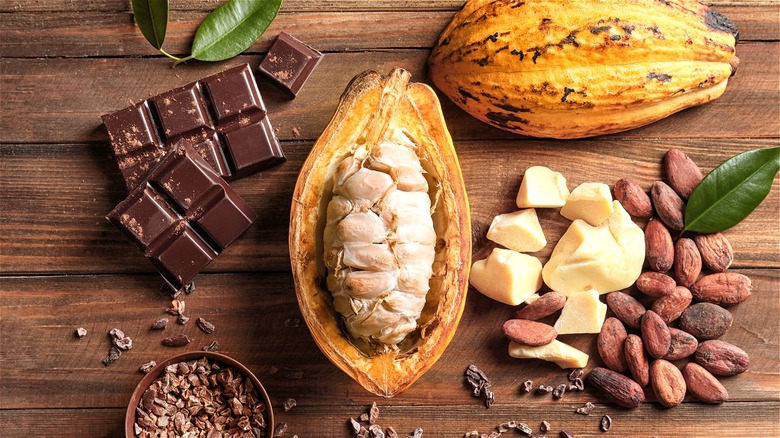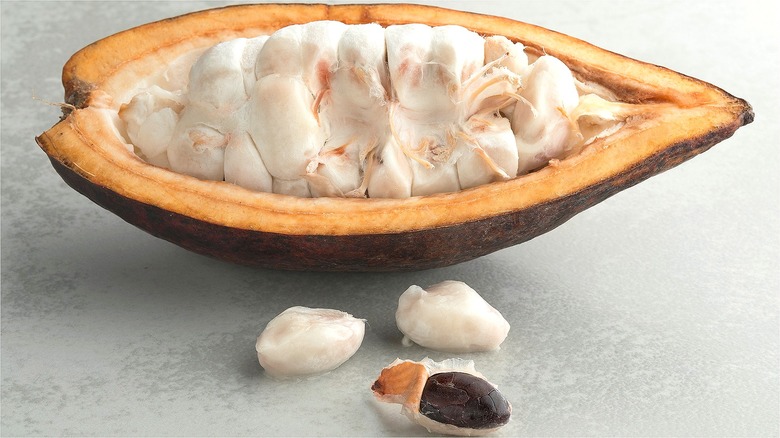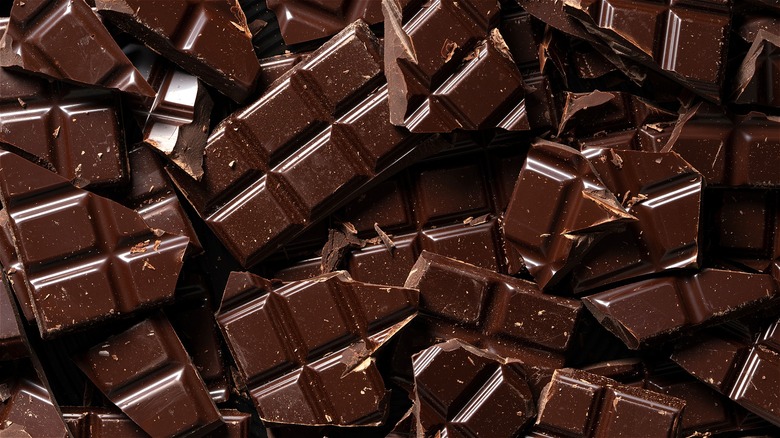How Are You Meant To Eat Cacao Fruit?
Even the most novice home cooks are familiar with chocolate, but consuming the fleshy fruit surrounding raw cacao beans is anything but a mainstream practice. Cacao fruits are grown on the Theobroma cacao tree. This long, curved fruit is grown primarily for its highly prized inner seeds which are harvested and turned into cacao or cocoa powder through a long-winded fermentation process. Beyond the fruit's rough and thick exterior is a white bread-like substance that encases each precious cacao bean. While most of this stringy flesh becomes waste amidst the production of cacao powder, it's simple enough to eat this pulp-like fruit.
If you can find cacao pods at your nearest specialty supermarket, you're free to eat the soft pulp surrounding the cacao seeds by gently prying off the pale, opaque seeds with your hands or even your teeth. Beyond the stringy and juicy texture, your tastebuds will be pleasantly surprised by the expanse of complex flavors. Better still, there are a number of ways to experience the tropical fruit (from beverages to desserts beyond just chocolate bars), allowing curious eaters to appreciate all of its nuances.
Cacao flesh houses surprisingly bright flavors
Before you attempt to pry cacao flesh off those precious inner seeds, you might be curious to know what you're about to experience. Even though cacao fruit in Costa Rica, may look intimidating hanging in all its oblong glory, once you've successfully found a way inside that hard exterior, the enjoying part is easy. While cacao fruit typically emits a floral essence, the flavor of the inner pulp can also tout floral or earthy undertones as well.
As a study published in Molecules points out, one of the things that makes cacao pulp so unique is that, depending on where your specific fruit was sourced, the flesh may have a completely different flavor profile than a fruit harvested from a different region. Cacao trees grow around the world, yielding an array of unique flavor notes even among the four most common types. In general, however, the cacao pulp does have a tart, fruity essence and can range from tasting like lychee and strawberry to mango and plum. The most notable characteristic of this white, fleshy fruit is the nuanced flavor of chocolate you may experience with each bite. Besides eating this soft and stringy fruit straight from the pod, the fruit surrounding the popular cacao seed can of course also be turned into delicious chocolate bars without having to rely on Hershey or Wonka.
The many ways cacao fruit is consumed
Next to eating this white slippery fruit raw by biting around those pesky bitter seeds, you might find that you truly enjoy the flavor of cacao flesh but wish you could use the stringy portions with more intention. Luckily, there are products available that allow you to experience the wide range of flavors cacao fruit has to offer without any additional work on your part. You can purchase whole fruit chocolate which is essentially chocolate bars and pieces made only from the cacao fruit itself. This is a great way to experience cacao pulp's complex fruity flavors without added sugar. It also minimizes food waste. For an even tangier sweet treat, you can turn the pulp into ganache.
Besides chocolate bars, a few companies have decided to use cacao pulp to make refreshing juice and even cacao fruit liquor. Of the nonalcoholic version, culinary influencer and former MasterChef contestant Nick DiGiovanni claimed "this is the new coconut water" during a juicing demonstration on TikTok. While cacao liquor is the perfect ingredient to add to your lineup of great winter weather cocktails, you should be diligent about reading ingredients, since some varieties are made from cacao nibs instead of pulp. Whether you decide to eat this chocolatey flesh straight from the source or buy a cacao fruit-infused product, you're sure to enjoy the variety of flavors this unexpected fruit has to offer.


